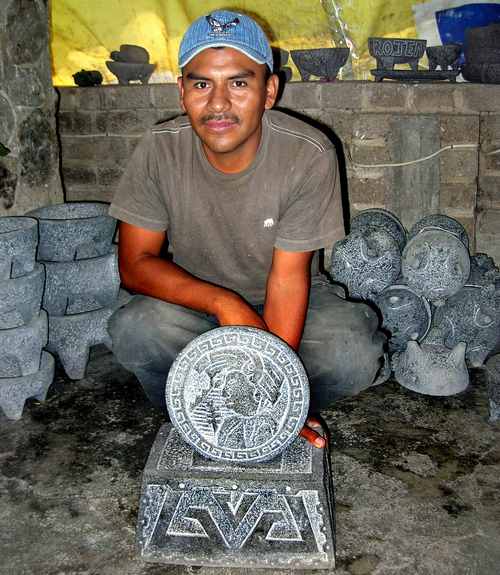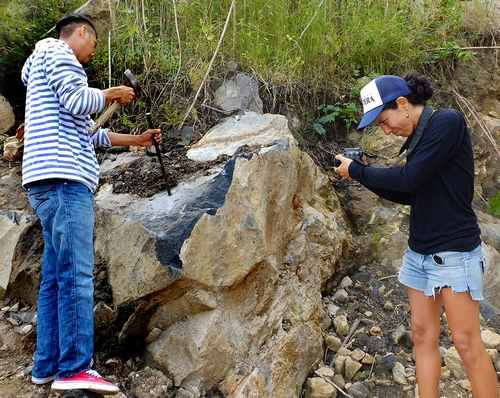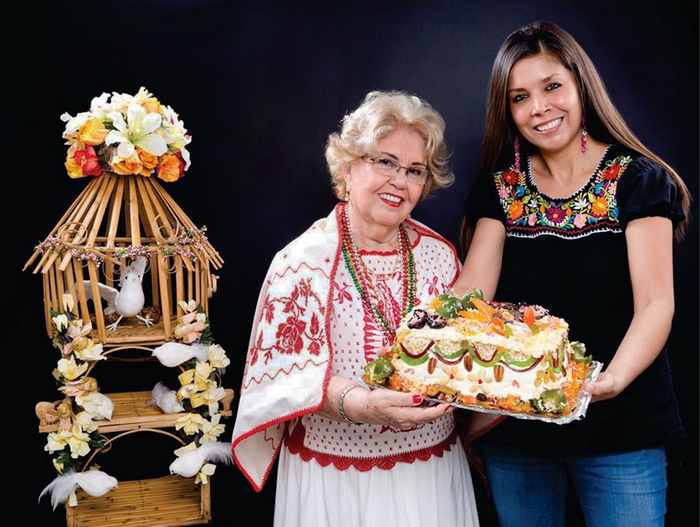|
By
John Pint
 San
Lucas Evangelista is one of those sleepy little communities lying along
the shore of Lake Cajititlán, just 20 kilometers south of Guadalajara,
and 20 northwest of Lake Chapala. Well, sleepy it may appear if you
walk around the plaza and fail to spot even a stray dog, but don’t be
deceived by appearances. There’s plenty of activity going on behind the
scenes in almost every backyard, for this little town has been home to
makers of metates
and molcajetes
for at least 600 years and probably a lot more. Metates, of course, are
flat slabs of volcanic rock for grinding lime-softened corn, while
molcajetes are round mortars traditionally with three legs, used for
pulverizing chili peppers, tomatoes and other ingredients used in
salsas. Today, as in the past, each of these kitchen tools is hand-made
from appropriate native rock which, as you might suspect, can be found
in great abundance only minutes from the village. San
Lucas Evangelista is one of those sleepy little communities lying along
the shore of Lake Cajititlán, just 20 kilometers south of Guadalajara,
and 20 northwest of Lake Chapala. Well, sleepy it may appear if you
walk around the plaza and fail to spot even a stray dog, but don’t be
deceived by appearances. There’s plenty of activity going on behind the
scenes in almost every backyard, for this little town has been home to
makers of metates
and molcajetes
for at least 600 years and probably a lot more. Metates, of course, are
flat slabs of volcanic rock for grinding lime-softened corn, while
molcajetes are round mortars traditionally with three legs, used for
pulverizing chili peppers, tomatoes and other ingredients used in
salsas. Today, as in the past, each of these kitchen tools is hand-made
from appropriate native rock which, as you might suspect, can be found
in great abundance only minutes from the village.
When
we first wandered into San Lucas Evangelista, we had no idea where to
find the basalt sculptors, but after knocking on a few doors, we were
welcomed into the home of Victor Cocula, who told us he was one of some
300 local people who follow the long standing tradition of transforming
the hard local rock into practical appliances as well as works of art.
Such
items, in fact, can be found in every corner of Cocula’s living room
and included busts, commemorative plaques and clever water filters
along with the traditional mortars. “My ancestors have been making
things like these for a very long time,” Cocula told me. “In fact, only
recently a neighbor dug up a metate in the local cemetery which amazed
all the craftsmen of the village. It appears to be some 600 years old,
decorated with the head of a dog. The quality of workmanship is
extraordinary. There are no tell-tale chisel marks on it anywhere—in
fact, it’s so smooth it appears to have been machined. We can’t explain
how it was done, but it’s proof positive that sculptors have been at
work here for a long, long time.”
By
now, of course, I was dying to observe the process by which these items
had been made and I immediately accepted Victor Cocula’s offer to take
me to the nearby basalt mines where the rock is extracted.
It
turned out the mines—quarries really—were only a half hour’s walk from
the village, just up the hill on the way to El Cerro Viejo, which looms
on the horizon.
We
climbed down into a long, deep man-made gully which seemed to go on
forever. The steep walls on either side consist of basalt boulders
undermined by decades of digging, and are anything but stable. “Over
the years,” said Victor’s father, “we’ve lost five people to rock falls
in these mines. Two of them died quite recently.”
We
arrived at the family’s favorite spot along the trench and—while his
father deftly turned out a dozen “manos” (pestles), Victor walked me
through the process of converting a rock into a sculpture.
“We are
fortunate people here,” he told me as he tapped several rocks with a
short hand pick. “If we need 100 pesos for something, we just walk up
the hill to the mine and look for a rock that could be turned into a
molcajete.”
He
went over to a bowling-ball sized rock embedded in the wall of the
trench, knocked the dirt off one spot and tapped the rock with the
pointy end of his pick, producing small pits in the surface. “This rock
is fine-grained but not too hard. See? All the holes are very tiny.
Besides that, it has no sand embedded in it. The last thing people want
is to find grains of sand in their salsa.”
He
lifted the rock and, like a true Mexican Michelangelo, said: “I see a
molcajete inside. I could turn this into a five-inch-diameter round one
or a heart-shaped one. Now, the round one would bring me 70 pesos while
the heart-shape will be worth 150 pesos, so I’ll go for the latter. OK,
it looks like there’s enough rock here to put three legs on this
mortar, but first I have to check if there are any natural faults.”
A
few swift blows revealed just such a fault and the craftsman removed a
one-inch layer, leaving the rock flat on the bottom. “Oops, not enough
room for legs anymore, but it’ll still make a fine piece. Now I have to
see if this rock has “hilo.”
This, he explained,
means that the rock will fracture in the direction the sculptor
intends, rather than “doing its own thing.”
“Qué
bueno,” said Victor. “It has hilo,” and he deftly used the flat end of
his pick to quickly give the rock the external shape he wanted. Then he
turned the pick around and used the pointed end to begin hollowing it
out. “These blows must be neither too heavy nor too light,” he
commented as tiny chips flew everywhere.
“Don’t
you ever get a piece in your eye? I asked, noting that neither he nor
his father was wearing goggles. “Ha! All the time,” he said laughing.
“Sí sí,” chimed in his
father: chips in the eye siempre!”
The
rock now looked like a heart-shaped mortar and would be carried back
down to Victor’s back yard for some two to three hours of fine tuning
and smoothing. But before we left the mine, my companions walked me
over to an enormous boulder.
“My
family, the Coculas, have a project. We want to create the world’s
largest molcajete. A year ago, we made one 1.7 meters in diameter and
64 centimeters high, decorated with chiles and tomatoes. It weighs
between 800 and 850 kilos and is on permanent display at the original
Burritos de Moyahua restaurant in Zacatecas. Someday we hope to break
our record and make one over two meters long. I'm hoping this big rock
might have all the right characteristics.”
It
may be a while before the Coculas turn out the world's largest
molcajete, but, meanwhile, if you would like to see
some of
the "ordinary" creations produced by the sculptors of San Lucas, you
can chat with Victor Cocula almost any Sunday at the plaza in Ajijic,
where you’ll find him selling mortars and sculptures made of
basalt...or you can let Google Earth lead you to the plaza of San Lucas
Colima talent-hunters
learn from Jalisco basalt sculptors
By John Pint
 With
the Colima volcano filling the air with fireworks almost daily, it is
no wonder that visitors to the state of Colima are asking for souvenirs
related to El Volcán. With
the Colima volcano filling the air with fireworks almost daily, it is
no wonder that visitors to the state of Colima are asking for souvenirs
related to El Volcán.
Molcajetes
shaped like little volcanoes seemed like a good
idea to Mara Íñiguez, founder of Aprecio por México, a Colima-based
organization dedicated to supporting Mexican artisans.
Íñiguez then
discovered the elegant and innovative molcajete designs of Guadalajara
artist Paula
Durán, which combine an interior of volcanic rock with a
pinewood base, making the mortar much lighter, more attractive and more
practical for serving hot dishes. Durán's design seemed the perfect
item to offer tourists in Colima.
There was only one problem: local artisans knew very little about
working basalt, the hard rock from which molcajetes are made.
Perhaps
inspired by the fact that most of the so-called Volcán de Colima is in
Jalisco, Íñiguez decided to draw upon the skills of the
basalt
sculptors of San Lucas Evangelista on the edge of Lake Cajititlán,
located about 20 kilometers south of Guadalajara.
Well,
I had learned a lot about molcajete making during my previous visit to
the basalt sculptors of San Lucas (see above), but had missed the part
about using explosives to get at that basalt, all of which explains why
I now found myself watching rocks being blown to pieces on the hillside
above San Lucas.
“First I use a sledge hammer and chisel to
drill a hole about three hands deep,” says artisan Adrián Rodríguez,
“and then I put a packet of fine-grain gunpowder at the bottom of it.”
For
a fuse, Rodríguez used a sort of plastic drinking straw, again
carefully filled with gunpowder. Techniques like this provide local
sculptors with the chunks of rock they need for making—you guessed
it—molcajetes, which, these days are most often crafted with the help
of stone-cutting machinery and lathes. “It used to take us all day to
make one molcajete,” Rodríguez told me, “but with machines we can turn
them out fast. I just filled an order for one thousand.”
As he
spoke, Rodríguez' techniques were being filmed by audiovisual
specialist Cecilia Guerrero for a documentary which she and Íñiguez
will present to Colima officials for the benefit of local sculptors who
want to catch up with their Jalisco cousins.
“Aprecio por
México,” says Íñiguez, “has been working on projects like this one for
four years. We have helped artisans teach people how to make charming
Catrinas (elegantly dressed skeletons for the Day of the Dead) out of
cardboard and we got herbalists to teach the public about medicinal
plants. We've rescued traditional textile-making techniques and nearly
forgotten recipes. Maybe the most memorable of them was the complicated
process for baking an Ante Colimate, a kind of cake containing pine
nuts, coconuts, pineapple, lemon and liquor, which is served inside of
a wicker birdcage. It takes three days to make it and there's a very
ancient ritual for presenting it.”

I asked Íñiguez how she
got started assisting artisans.
“It
all began with pinwheels,” she told me. “I was traveling in Puebla and
on the roadside I saw the most amazing pinwheels. They were
large and
made of wood, carved into the shapes of birds and flowers. They were
gorgeous and I offered to present the craftsman's work in other places
so he would become known. That was where it all began. I became a sort
of cazatalentos,
a talent hunter.”
Aprecio por México can be
reached by phone at CELL 312 554 4000 and on Facebook .
For the time being, you won't find the cool
basalt-and-pine molcajetes there, but you soon will. I bet there are
already a few Colima sculptors trying to figure out where to obtain
gunpowder at this very moment.
|

